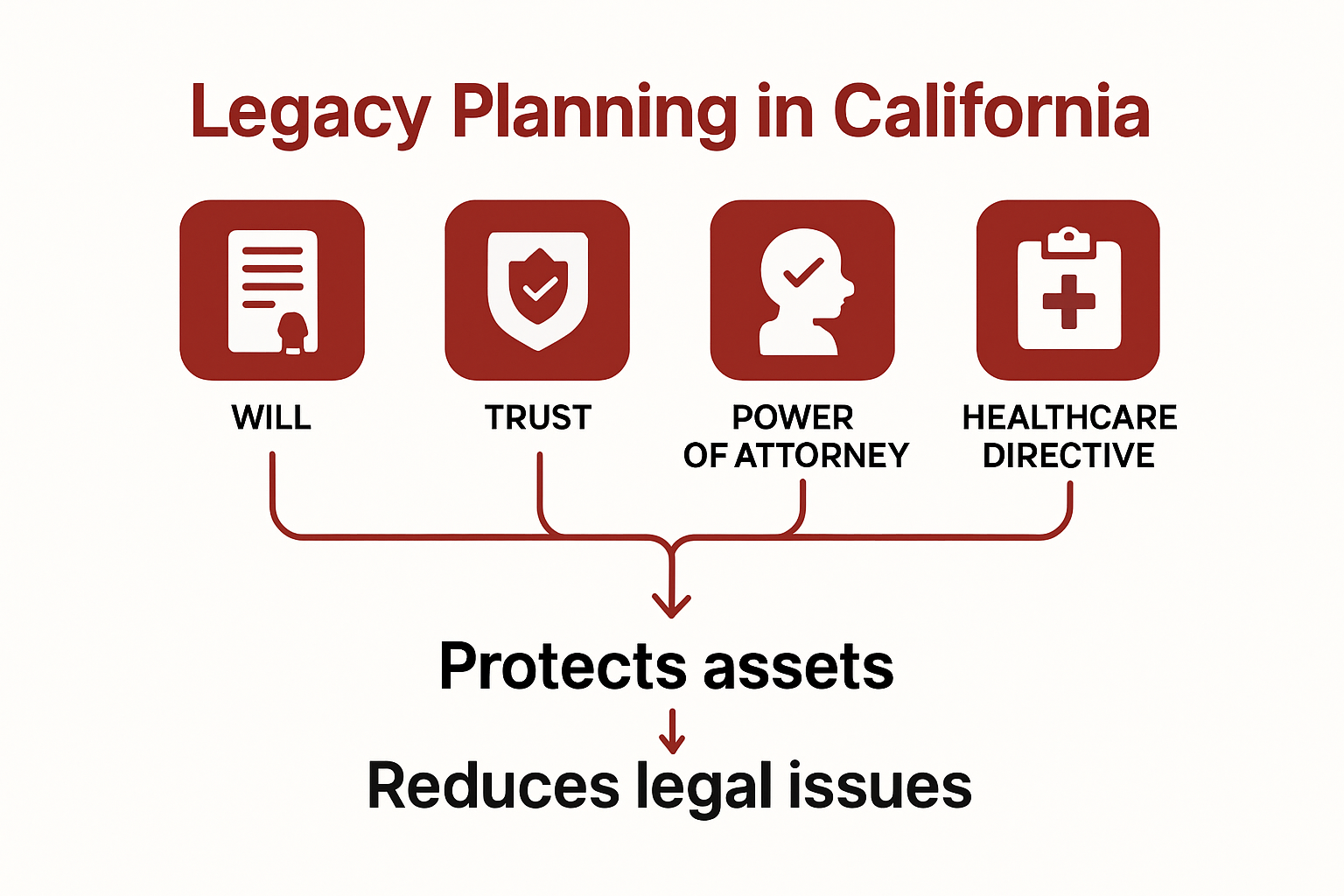
PARENTS & HOMEOWNERS: MY 7-STEP ESTATE PLANNING PROCESS WILL PROTECT YOUR HEIRS
From Creditors, Predators & Bad Choices, And Will Help You Become a (Bigger) Hero to Your Family!



Legacy Planning Strategies for California Families 2025
Legacy planning in California is more than just a legal checklist and it can affect your family’s comfort, privacy, and peace for generations. Families are often shocked once they learn that nearly 60 percent of Californians have no estate plan at all, leaving millions at risk of public probate battles and legal chaos. Most people assume estate planning is only for the wealthy but the real surprise is how crucial even basic steps can be for preserving family harmony and protecting everything you worked for.
Table of Contents
- Understanding Legacy Planning Needs In California
- Key Estate Protection Strategies For Families
- Preventing Common Inheritance Risks And Family Disputes
- Adapting Your Plan For Life Changes And California Laws
Quick Summary
| Takeaway | Explanation |
|---|---|
| Establish critical estate documents | Create financial power of attorney, advanced healthcare directive, and a comprehensive will to protect your family. |
| Utilize trust structures effectively | Choose between revocable and irrevocable trusts to optimize asset protection and ensure flexibility for your family’s needs. |
| Engage in proactive estate management | Regularly review and update your estate plan to reflect life changes and comply with evolving California laws. |
| Implement clear communication strategies | Foster open discussions about estate plans to avoid inheritance disputes and clarify intentions among family members. |
| Consult professionals for estate planning | Seek legal and financial advice to tailor your legacy plan and navigate complex legal landscapes effectively. |
Understanding Legacy Planning Needs in California
Legacy planning in California represents a critical financial strategy for families seeking to protect their assets, secure their children’s future, and navigate the complex landscape of estate management. The Golden State’s unique legal and financial environment demands a sophisticated approach to preserving generational wealth and ensuring family stability.
The Critical Components of Effective Legacy Planning
California families face distinctive challenges that make comprehensive legacy planning more than just a financial recommendation – it’s a necessity. According to the California Department of Financial Protection and Innovation, a robust estate plan goes far beyond a simple will. It requires carefully crafted documents that address multiple dimensions of financial and personal protection.
The essential components typically include:
- Financial Power of Attorney: Enables trusted individuals to manage financial affairs if you become incapacitated
- Advanced Healthcare Directive: Ensures your medical wishes are honored when you cannot communicate them
- Comprehensive Will: Provides clear instructions for asset distribution and guardianship
Without these critical documents, families risk significant legal complications. The probate process in California can be lengthy and public, potentially exposing family financial details and creating unnecessary stress during already difficult times.
To help summarize the core estate planning documents and their purposes, here is a table for quick reference:
Estate Planning Documents and Their Functions:
| Document | Main Purpose |
|---|---|
| Financial Power of Attorney | Assigns a trusted individual to manage your financial affairs |
| Advanced Healthcare Directive | Communicates your healthcare wishes if you become incapacitated |
| Comprehensive Will | Provides instructions for asset distribution and guardianship |
Protecting Family Wealth in a Complex Legal Environment
California’s complex legal landscape requires strategic planning to preserve family assets effectively. The California Attorney General’s Office emphasizes the importance of proactive end-of-life care planning to prevent potential family crises and financial hardships.
For high-net-worth families, legacy planning becomes even more nuanced. It’s not just about transferring assets, but about creating a sustainable framework that protects wealth across generations. This involves understanding tax implications, creating trusts that provide flexibility, and developing strategies that prevent potential conflicts among heirs.

Strategic Considerations for California Families
Successful legacy planning in California requires a holistic approach that considers multiple factors. Families must think beyond immediate asset transfer and consider long-term implications. Learn more about California-specific estate planning strategies that can help protect your family’s financial future.
Key strategic considerations include:
- Understanding California’s community property laws
- Evaluating potential tax implications of asset transfers
- Creating flexible trust structures that adapt to changing family dynamics
- Implementing protection strategies against potential legal challenges
The goal of legacy planning is not just wealth preservation, but creating a sustainable framework that supports family goals, provides financial security, and minimizes potential legal complications. By taking a proactive and comprehensive approach, California families can build a robust strategy that protects their hard-earned assets and provides clear guidance for future generations.
Key Estate Protection Strategies for Families
Estate protection strategies are crucial for California families seeking to preserve their wealth, minimize tax liabilities, and ensure a smooth transition of assets to future generations. Understanding and implementing comprehensive protection mechanisms can shield families from potential financial vulnerabilities and legal complications.
Trust Structures: A Foundation of Asset Protection
Trusts represent a powerful tool in estate protection, offering families flexibility and control over asset distribution. According to Davidson Estate Law, different trust structures provide varying levels of protection and benefits. Irrevocable trusts, for instance, can effectively shield assets from potential creditors by removing them from direct estate ownership.
Two primary trust categories families should consider include:
- Revocable Living Trusts: Provide flexibility and facilitate smooth asset transition
- Irrevocable Trusts: Offer stronger asset protection but require relinquishing direct control
The selection between these trust types depends on individual family dynamics, financial goals, and potential risk exposure. Explore detailed strategies for safeguarding your legacy to make informed decisions.
For easy comparison, see the table below highlighting the key differences between Revocable and Irrevocable Trusts:
| Trust Type | Flexibility | Asset Protection | Control Over Assets | Probate Avoidance |
|---|---|---|---|---|
| Revocable Living Trust | High | Moderate | Grantor retains control | Yes |
| Irrevocable Trust | Low | High | Grantor gives up control | Yes |
Legal Instruments for Comprehensive Asset Protection
Effective estate protection extends beyond trust creation. The California Attorney General’s Office emphasizes the importance of strategic legal instruments that control asset distribution and minimize potential disputes.
Key legal strategies include:
- Designating specific beneficiaries for financial accounts
- Creating clear, legally binding instructions for asset distribution
- Establishing power of attorney for financial and healthcare decisions
- Implementing advanced healthcare directives
These instruments ensure that your assets are distributed according to your precise wishes, bypassing potentially complicated intestate succession processes.
Proactive Risk Management and Financial Planning
Successful estate protection requires a holistic approach that anticipates potential challenges. Families must develop comprehensive strategies that address various financial and legal risks. This involves regular review and updating of estate documents, understanding changing tax laws, and creating flexible frameworks that can adapt to evolving family circumstances.
Critical considerations in proactive estate protection include:
- Regular review of beneficiary designations
- Understanding potential tax implications of asset transfers
- Creating contingency plans for unexpected life events
- Maintaining detailed documentation of assets and intentions
By implementing these strategies, California families can create robust estate protection frameworks that preserve wealth, minimize legal complications, and provide clear guidance for future generations. Proactive planning is not just about protecting assets but about creating a lasting legacy that reflects your family’s values and financial goals.
Preventing Common Inheritance Risks and Family Disputes
Inheritance disputes can tear families apart, transforming what should be a time of grief and remembrance into a contentious legal battleground. California families face unique challenges in managing estate transitions, requiring strategic planning and proactive communication to minimize potential conflicts and preserve familial relationships.
Understanding the Root Causes of Inheritance Conflicts
According to the Sterling Law Group, ambiguous estate planning is the primary catalyst for inheritance disputes. Lack of clarity in estate documents can lead to multiple interpretations, creating tension and legal challenges among potential heirs.
Common sources of inheritance conflicts include:
- Unclear asset distribution instructions
- Perceived inequitable inheritance allocations
- Unexpected beneficiary designations
- Lack of transparency in estate planning process
- Complex family dynamics and unresolved historical tensions
Addressing these potential flashpoints requires a comprehensive and thoughtful approach to estate planning that goes beyond mere legal documentation.
To help visualize the key causes of inheritance conflicts, here is a summary table:
| Cause of Conflict | Description |
|---|---|
| Unclear distribution instructions | Instructions open to different interpretations |
| Inequitable inheritance allocations | Heirs perceive unfairness in share sizes |
| Unexpected beneficiary designations | Surprises in who is selected to receive assets |
| Lack of transparency | Family members not informed about plan details |
| Complex family dynamics | Past disputes or blended families increase tensions |
Strategic Communication and Documentation
The Ferguson Law Group recommends using a revocable living trust as an effective strategy to bypass probate and maintain family harmony. Creating a personal property memorandum can help specify the distribution of tangible items, reducing ambiguity and potential conflicts.
Key strategies for preventing inheritance disputes include:
- Conducting transparent family discussions about estate plans
- Documenting specific intentions for asset distribution
- Creating clear, legally binding instructions
- Considering the emotional impact of inheritance decisions
Learn more about facilitating family discussions on estate planning to help navigate these sensitive conversations effectively.
Proactive Legal and Emotional Strategies
Preventing inheritance disputes requires a holistic approach that balances legal precision with emotional intelligence. Families must create estate plans that not only protect assets but also preserve relationships and respect individual family member’s feelings and expectations.
Recommended approaches include:
- Regular review and updating of estate documents
- Engaging professional mediation services
- Creating fair and transparent inheritance frameworks
- Considering individual family member’s unique circumstances
- Providing clear explanations for inheritance decisions
By implementing these strategies, California families can develop robust estate plans that minimize the risk of disputes, protect generational wealth, and maintain familial bonds. The goal is not just legal compliance, but creating a supportive framework that honors the family’s legacy and individual members’ emotional needs.
Adapting Your Plan for Life Changes and California Laws
Legacy planning is not a one-time event but a dynamic process that requires continuous attention and adaptation. California families must remain vigilant about updating their estate plans to reflect significant life changes, evolving legal landscapes, and shifting personal circumstances.
Navigating Life Transitions and Legal Shifts
California’s Master Plan for Aging highlights the critical importance of flexible estate planning that can accommodate the complex journey of life transitions. Significant events such as marriage, divorce, birth of children, career changes, and unexpected health challenges demand immediate review and potential modification of existing estate documents.
Key life events that necessitate estate plan updates include:
- Marriage or divorce
- Birth or adoption of children
- Significant changes in financial status
- Inheritance or substantial asset acquisition
- Relocation to a different state
- Changes in family health circumstances
The following table offers a quick-reference checklist for life events that should trigger an estate plan review:
| Life Event | Should You Review Your Estate Plan? |
|---|---|
| Marriage or Divorce | Yes |
| Birth or Adoption of Child | Yes |
| Significant Change in Financial Status | Yes |
| Inheritance or Substantial Asset Acquisition | Yes |
| Relocation to Different State | Yes |
| Changes in Family Health Circumstances | Yes |
Understanding these triggers helps families proactively manage their legacy planning strategies and prevent potential legal complications.
Legal Landscape and Statutory Changes
In 2022, Governor Newsom signed AB 1663, which reformed California’s probate conservatorship system. Such legislative changes underscore the importance of regularly reviewing and updating estate plans to ensure compliance with current legal standards.
Critical legal considerations for California families include:
- Understanding recent changes in state inheritance laws
- Reviewing beneficiary designations
- Assessing tax implications of current estate structures
- Ensuring healthcare directives reflect current medical decision-making preferences
Learn about updating your estate documents to align with California laws to maintain the effectiveness of your legacy planning strategy.
Proactive Estate Plan Maintenance
According to the California Department of Financial Protection and Innovation, a comprehensive estate plan should be reviewed at least every three to five years or immediately following significant life events. This approach ensures that your legacy planning remains responsive to your family’s evolving needs and the dynamic legal environment.
Recommended maintenance strategies include:
- Scheduling regular estate plan reviews
- Consulting with legal and financial professionals
- Maintaining detailed documentation of assets and intentions
- Communicating estate plan details with key family members
- Creating contingency plans for unexpected scenarios
By adopting a proactive and flexible approach to estate planning, California families can create robust legacy protection frameworks that adapt to changing circumstances. The goal is to develop a living document that grows and evolves with your family, providing peace of mind and financial security across generations.

Frequently Asked Questions
What is legacy planning and why is it important for California families?
Legacy planning is a comprehensive strategy that helps families protect their assets, ensure the well-being of their dependents, and facilitate a smooth transition of wealth. It’s crucial for avoiding probate battles and legal disputes after death, which can cause stress and financial strain on loved ones.
What essential documents should be included in a legacy plan?
A robust legacy plan typically includes a financial power of attorney, an advanced healthcare directive, and a comprehensive will. These documents help manage financial and medical decisions and provide clear instructions for asset distribution.
How can trust structures help in estate protection?
Trust structures, such as revocable and irrevocable trusts, can provide significant asset protection. Revocable trusts allow for flexibility in managing and distributing assets, while irrevocable trusts can shield assets from creditors and reduce estate taxes by removing assets from direct ownership.
What steps can families take to prevent inheritance disputes?
To minimize inheritance disputes, families should engage in transparent communication about estate plans, document specific intentions for asset distribution, and create clear, legally binding instructions. Regularly reviewing and updating estate documents can also help address potential areas of conflict.
Protect Your Family’s Future With a Personalized Estate Plan
As this article highlights, legacy planning in California is full of challenges. From avoiding probate delays and public legal battles to making sure your loved ones follow your wishes, the risks are real. If you feel anxious about your estate documents or unsure whether your trust, will, and power of attorney cover everything your family needs, you are not alone. We understand the importance of asset protection, clear communication, and adaptability as explained throughout this guide. Get expert help tailored to California families at the Law Office of Eric Ridley | Estate Planning | Wills & Trusts.

Take the next step to secure your legacy and bring peace of mind to those you care about most. Visit https://ridleylawoffices.com today to schedule a confidential conversation about your estate plan. Put experience on your side and move forward with confidence knowing your legacy is protected.
Recommended
- Family Legacy Planning in California: Secure Your Wealth for 2025 – Law Office of Eric Ridley
- Estate Planning Checklist 2025: Protecting California Families – Law Office of Eric Ridley
- Estate Planning for Parents in California: Protecting Wealth in 2025 – Law Office of Eric Ridley
- Estate Planning for Families in California: Protecting Wealth in 2025 – Law Office of Eric Ridley
- How to Create a Notarized Will in Ontario (2025 Guide) – My Mobile Notary
- Age Discrimination Examples: You Need To Know This
